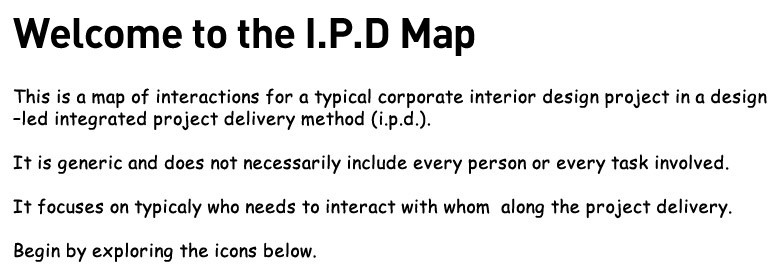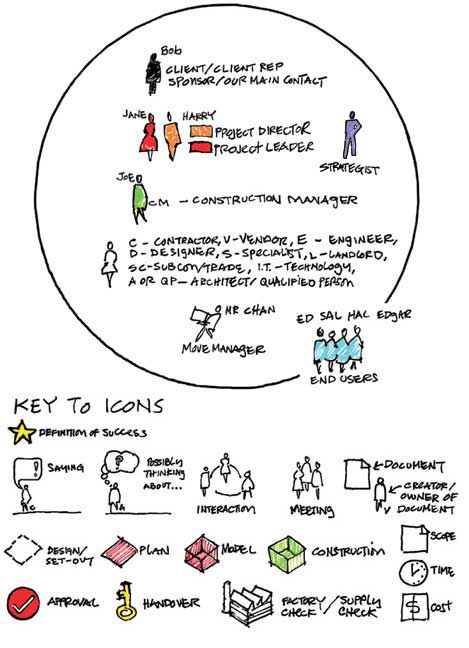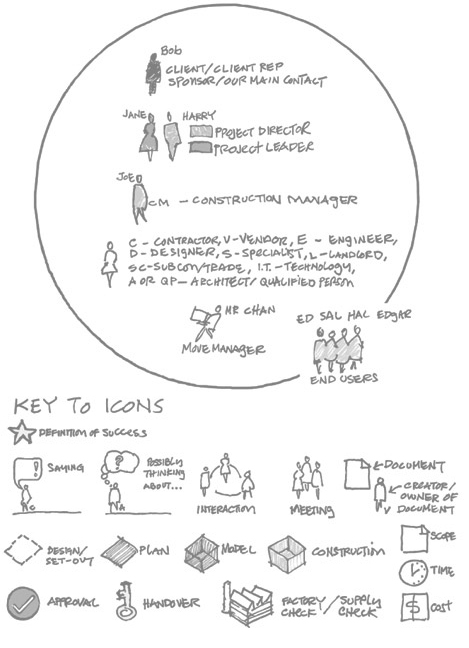Download Maps
Download different versions of the IPD map here.
The IPD (integrated project delivery) map is a banner that flowcharts the generic interactions commonly occurring in M Moser’s process of designing and building a workplace.
Generally yes. The map reads left to right. But some processes can be repeated steps so you could, if you like trace connections backwards as well as forwards.
The map was first introduced at a project directorship conference attended by over 50 of our most senior directors in June of 2010 where the IPD map was analyzed by all over a three day period. You can see the conference notes here.
It was concluded by the attendees that this is a good representation of what we do for most workplace projects. It has remained on display and actively referred to by nearly all offices.
Certainly not. As we at M Moser increasingly handle complex and sophisticated projects there could be significant variance in the phases and activities.
But this is still relevant for a starting point to see how your project may vary.
Other maps to describe very specific projects have been done. There is one example here. You are very welcome to develop your own flowcharts.
In fact, you are encouraged to do so!
All hand drawn icons symbols and figures are digitized and available for download to be used in any way you like in our Sketch Graphics page here.
Yes. Just send an email to ODteam@mmoser.com or contact the director of
Organisational Development Charles Corley at charlesc@mmoser.com
It certainly can and should. Many features have been added since it was made into an interactive website and it can potentially be changed and added to.
None of our references, tools and systems are static or memorialized as unchangeable.
Yes but you should do so in person. Never send the map to a client and expect them to read and understand it.You should present it in person.
Mostly likely a printed banner 600 mm tall by approximately 2.5 meters long is best (downloadable here) but you can use a client version of the online version here.
There is no difference between this version and the client version except that the dialog boxes for in-house learning are not activated when you click on a phase across the top of the map.
You can use the url here.
Just save it to your favorites in your phone or tablet and you will always have it with you. It is available from anywhere worldwide.
You don’t need to be on our intranet. The on line version is responsive and will adapt to your screen size.
Certainly. Capturing and using pieces of the map just for action and color to imply a process in a presentation has been done many times before.
Some already appear in the IPD map sketches here.
The map was conceived of by Moira Moser and drawn by Charles Corley in
consultation with her.
Download different versions of the IPD map here.
New here? Click here to see a video on how to navigate this site.

This is a map of collaboration and communication for a typical corporate interior design project in a design led integrated project delivery method (i.p.d.).
It is generic and does not necessarily include every person or every task involved.
It focuses on typically who needs to collaborate with whom along the project delivery.
Begin by exploring the icons representing the team.


The client or key client contact is often one person but there are usually several people on the client team who are influential in different ways.
We strive to understand each of them as individuals.
The project director and project leaders are roles that are closely related.
The leader leads the team and owns the project on a day to day basis.
The director connects the leader to the organisational goals and is responsible for making the leader successful.
This icon represents the construction management role or person with responsibility for overseeing construction.
On a small project this could be the designer.
On a project of average complexity and size it could be a separate individual.
On larger projects it could be a team of construction professionals.
Anyone can be represented on the map with an icon of a person and an abbreviation to represent their professional input or role.
It is a prompt to think about the names and individuals or teams that will carry out your project and how they will interact.
You could even develop and customize roles in your own map. This one for example represents a move manager.
You may want to add other roles in thinking about your particular project like strategic planner, business development professional or others.
This icon represents the end users who may have input approvals or decisions in the project. They could include department heads or any others that are ultimately the users of the final results.
We need to think about when and how we engage them in the process.
The icons represent typical things such as people, documents, approvals, design and construction.
Take a moment to familiarize yourself with them.


During both the brief / discovery phase as well as information gathering we consolidate and present information in a variety of ways.
They may be presentation boards, documents or reports, spreadsheets, graphs , powerpoints and other ways to discuss the project and create common understanding.
One of the most important things we can do is to have a full exploration and understanding of how success will be defined.
We need to revisit this “definition of success” at regular intervals through the project.
Whether it is expressed or not, trust is always a concern.
Mmoser project professionals develop trust and , through their actions and integrity, are worthy of trust placed in them.
It is the cornerstone of all we do.
A brief is taken and quite often there are interviews with key stakeholders or end users as well. The key client contact may come along with others to this meeting. We may choose to bring some of our team members with us depending on the project challenges likely to be faced and the expertise needed to take the brief fully.
Aside from facts and figures we need to explore the deeper issues of goals, values and objectives.
They often relate to the business objectives of the company or special needs not expressed in other data.
It is always very important we visit and familiarize ourselves with the site conditions.
We normally also have to obtain and understand landlord fit out guidelines.
The project leader and project director need to keep the lines of communication open with the client contact responsible for the project. This usually includes constant informal discussions in person or by phone or mail. They will work very closely together.
All that we learn through briefings, research interviews and information gathering should be consolidated as criteria for the project development.
Sometimes, especially when there is significant change ahead for a client organisation, deeper exploration of the potential for the project may be useful.
This is sometimes done through special studies or workshops that engage stakeholders or end users to discover together how the brief may be developed.
Early on in a project the understanding of budget, costs, project timing and overall scope need to be established and agreed.
Sometimes a regional or global procurement person from the clients organisation may be involved.
The client’s I.T. manager and team may be involved and have requirements to be met.
Their requirements and definition of success will need to be added to the overall objectives.
Their team’s scope and actions will need to be coordinated with the project delivery.
All of the information and goals need to be discussed, understood and agreed.
When there is change later on, this needs to be reviewed and agreed as well.
Once the schematic design begins there may still be unknowns and concerns, spoken and unspoken.
The team will need to ensure the right resources and skills are brought to the project.
Developing clear, inclusive and open team communication becomes vital.
As the project progresses all project related people who have a role to play in the successful delivery are involved as early and proactively as possible.
This is both a development of the design and systems integration to develop construction information.
At agreed intervals, there are presentations and discussions to discuss options, review progress and look at next steps.
Feedback from these sessions will usually result in further refinement of the design.
Changes can be brought about through many sources.
The impact on a project that has established goals, budgets and timelines needs assessment.
Minor change may be absorbed into the project right away.
If it is more substantial it may require careful review and agreement and could even potentially change the scope, cost timeline or project objectives.
At the early stages of design, there are checks to ensure the development of the design will comply to local regulation.
As the project becomes more defined materials, products and systems are specified.
Some may require careful tracking of the time it takes to fabricate and receive them.
Others need factory checks to ensure availability or suitability as well.
There are many inter-related activities to vendor selection and procurement.
Very often there are steering committees or regional / global client people who require updates of project status.
They usually meet less often. For example once a month is quite common.
Their input and guidance is sometimes crucial to keep the project on track.
At an agree point, even if all detail is not yet established, the project will commence on site.
Site set up in done and safety procedures and checks commence.
Normally the team will review site markings before permanent walls and fixtures are built.
There is a site startup meeting requiring attendance from all involved.
If the team has already worked closely before site work, there is normally smoother interaction because most issues, coordination and risks have been addressed early together.
The team tracts project status and all members contribute to the addressing of issues and opportunities.
At regular intervals the steering committee or client team is kept up to date of project status.
The client team will have their own parallel activities.
These may include a wide variety of activities including for example, what equipment both new and reused are needed, move management planning and notification to their own customers and contacts.
Throughout the project everyone is concerned with managing change and issues of time, cost or achieving the value expected.
The project is tracked through a few key documents.
The type and complexity of the tools used vary.
These are some of the more common documents.
Meetings and procedures to manage the move to a new premises may start quite early.
Throughout construction there will be many ad hoc or unplanned for meetings to address issues as they arise.
The people involved will vary greatly depending on the issues.
There are normally weekly meetings established for all participants to attend.
These are often held on site and may begin or end with a site inspection.
The departments or end users of the project are normally kept up to date in meetings to provide an opportunity for understanding and input.
There are often close working relationships between the key client contact and the mmoser project leader and construction manager to discuss opportunities risks and issues of all kinds.
An I.T. team may be working concurrently often in separate meetings throughout the project.
This may include migration of existing technology or installation of new technology but often both.
Coordination to the overall effort is crucial.
As the project nears completion, testing and commissioning of systems are carried out.
A project handover marks the point where the client takes over possession of the completed project.
Final detailed inspections of all types occur.
The most typical are related to building engineering (mechanical/ electrical fire service sand plumbing), design, construction and I.T.
The entire team is probably involved at some point
The most typical follow though activities involve the building of additional items, rectification of
non-conforming work and move management.
The follow up activities for project closeout usually require documenting of additional items being built after handover and the final accounts for the project.
Final accounts are prepared and the project is closed out.
There nees to be agreement on how additional items will be carried out, when the team can have access to carry out the work and how costs will be managed.
One of the most important measures of our work is a letter in the clients own words regarding our performance.
Project assessment and learning should occur to understand how well we achieved our definition of success and to continually improve.
After the project is closed out regular meetings occur to keep up to date with the clients evolution of their business and their needs.
The mmoser team continues to be of service.
